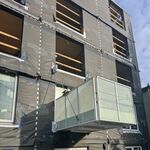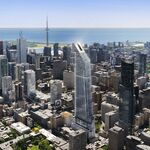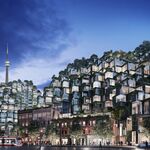Since April, 2013 Torontonians have been gripped by a conversation about what to do with the Billy Bishop Toronto Centre Airport, better known as the Island Airport. A proposal by Porter Airlines and the Toronto Port Authority (a federal agency) is currently asking Toronto City Council to allow passenger jets and an extension of the runway. In a city filled with vocal citizens and corporate lobbyists the issue is never black and white. To understand what’s at stake we’ll weigh both sides of the argument.
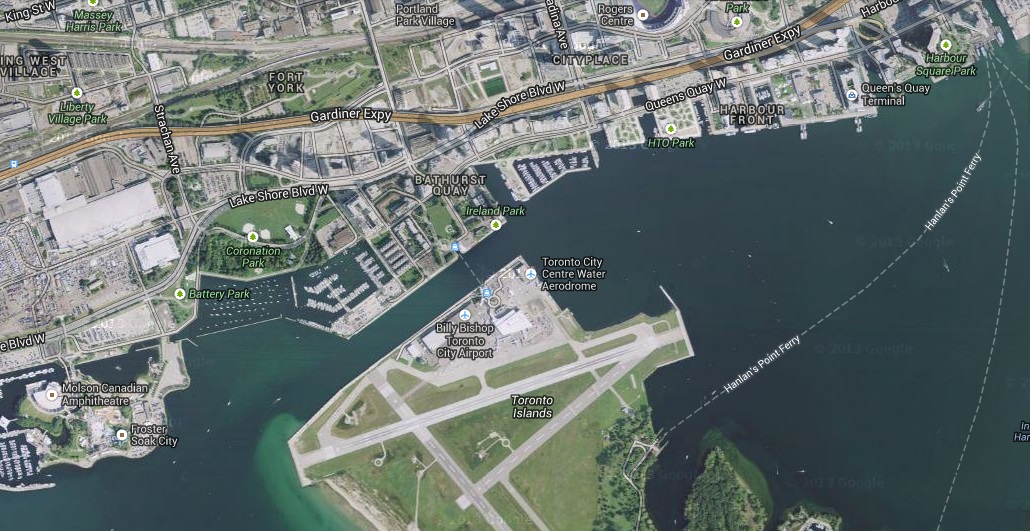 Aerial view of the immediate area and Airport, image from Google Maps
Aerial view of the immediate area and Airport, image from Google Maps
In 1983 the City of Toronto, Port Authority and Federal Government agreed to a 50-year Tripartite Agreement governing the use of the airport. It contained noise restrictions, aircraft restrictions and limitations to changes to the airport. In 1985 the agreement was modified to allow the Q400 aircraft model currently used by Porter to use the airport. In 2003 a second amendment was made permitting the construction of a tunnel between the mainland and the airport, expect to be completed this year.
Porter's proposal involves extending the runway by building into the lake to allow the Bombardier CS-100 jet to fly out of the island airport. It should be noted that should jets be allowed to fly out of the airport, any aircraft which meets the revised regulations put in place would be able to use the facility. Under Transport Canada regulations, a Runway End Safety Area must be added to the extension and both ends. The total extension at either end would be 900 feet or 274 meters minimum. The diagram from Porter shown below details how the new extension breaks down.
 Runway Extension breakdown, image courtesy of City of Toronto
Runway Extension breakdown, image courtesy of City of Toronto
The extension of the runway has created tension for those in the boating community who believe the Marine Exclusion Zone (MEZ), which set boundaries for how close boats can get to the airport will need to be enlarged, potentially choking off the important Western Gap marine passage and reducing the amount of space for sailors. Porter’s proposal stipulates changes to the angles of ascent and descent for planes taking off and landing which would leave the MEZ intact. Transport Canada however has yet to rule on whether these changes are acceptable and the leaving the status of the MEZ in question until Transport Canada releases its decision.
Under present airport conditions, City consultants estimate passenger loads could increase airport from 2.6 million to just under 4 million passengers per year. Allowing the larger Bombardier CS-100 with up to 125 seats and converting all 440 flight slots to commercial carriers, the passenger loads could double. Representatives of general aviation users have cried out against being pushed off the airport for commercial flight slots. These users would then need to be relocated to other airports across the region which might accommodate them.

While the airport currently fosters $1.9 billion in economic output, the expansion has the potential to bring in 2,000 direct and indirect jobs and support and an additional $250 million in economic output. The new planes also allow Porter to reach destinations as far as the Caribbean and Los Angeles. By reaching customers farther away Porter expects some of those economic increases to come from new tourism and spending in the city.
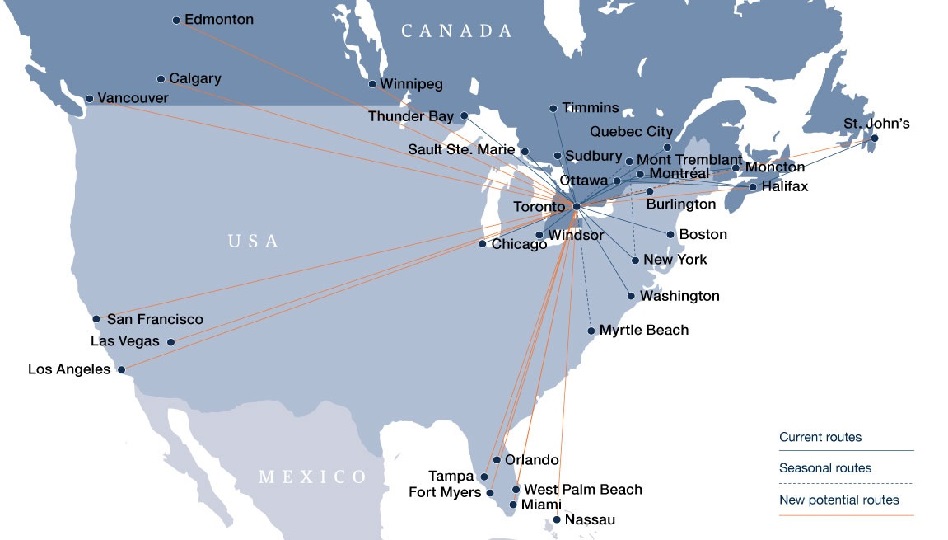 Proposed and Current Flight Routes served by Porter Airlines, image from Porter Airlines
Proposed and Current Flight Routes served by Porter Airlines, image from Porter Airlines
While this growth seems desirable, it may run opposite to our waterfront revitalization, spearheaded by Waterfront Toronto. Created in 2001 with the blessing of all three levels of government, Waterfront Toronto is charged with transforming nearly 2,000 acres of former industrial wasteland over 25 years into a sustainable mixed-use community. After 12 years in, the result is nothing short of extraordinary. With $1.26 billion in public investment towards parks, infrastructure and institutions, Waterfront Toronto has been able to generate $3.2 Billion in economic output, over 16,000 jobs and $622 million in government revenues. Development in the East Bayfront is expect to generate over $2.22 billion in economic output over 23,000 jobs and $838 million in government revenues while adding 10,000 new residences, 1.5 million square feet in commercial space and plenty of new retail space for the new community. The total effect of Waterfront Toronto’s smart investments has been to unlock $9.6 Billion in private sector development.
This investment however may be compromised with the airport proposal. In a December 2nd statement, the Board of Directors expressed serious concern about the impacts the existing airport has on the waterfront and cautioned that any expansion “has the potential to create significant risks for waterfront revitalization.” With the redevelopment of the Port Lands also in its early phases, changes to the character of the waterfront could affect its potential.
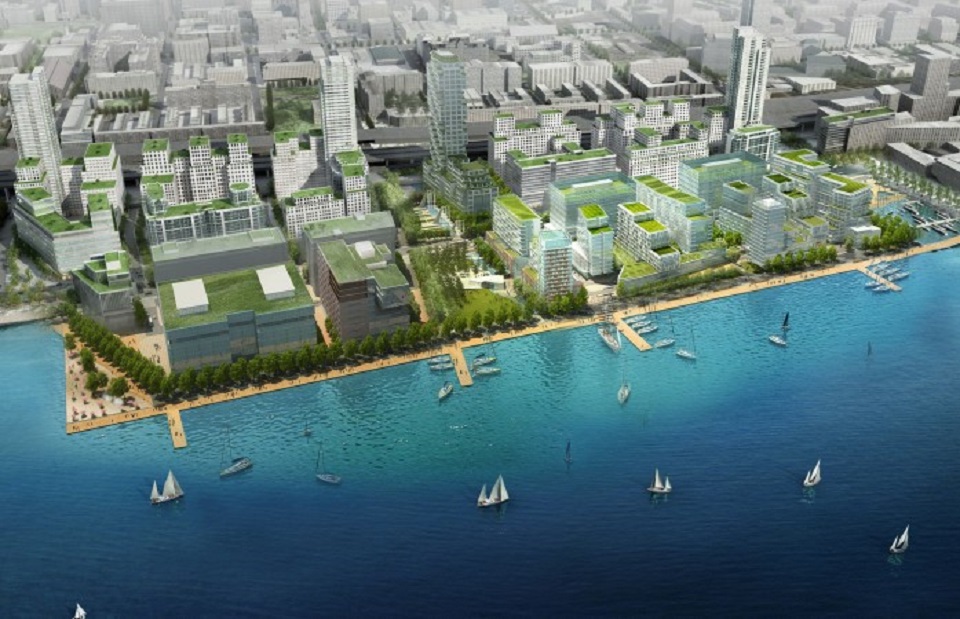 East Bayfront Community Artistic Rendering, image courtesy of Waterfront Toronto
East Bayfront Community Artistic Rendering, image courtesy of Waterfront Toronto
Another point of contention between both sides of the debate lies in the effects on the communities surrounding the airport and those under the flight path. The Tripartite Agreement sets out noise guidelines for all aircraft at the airport. These guidelines are meant to address the concerns of the nearby community and waterfront at large. With the CS-100 still working through the test flight phases, Bombardier has only been able to provide a small amount of noise data. Porter claims that this data is sufficient enough to show the aircraft meets the requirements, however the opposition has pointed out that it’s in Bombardier’s interest to present favourable data to sell more aircraft. Conclusive data from Transport Canada is not expected until the end of its aircraft approvals process.
The debate over expansion has also considered many of the social costs and benefits. Community advocates remain steadfast in their opposition to airport expansion given the number of concerns it brings now. Chief among them are traffic concerns for the area. With daily congestion making it nearly impossible to move around the Bathurst St and Lake Shore Blvd intersection over an increasing portion of the day. While Porter has added a shuttle bringing people from the downtown core to the airport, the vast majority of trips to and from the airport arrive by either private automobile or taxi. The Toronto Port Authority Draft Master Plan (recently made public) recognized traffic issues as a major point of concern for the airport. Limited by space and complexity of construction the report goes on to say that there are few viable solutions to easing airport traffic congestion and contemplates potential new garages to be built for cars or the use of land swaps with the city to secure new land to address the need for parking and traffic flow improvements.
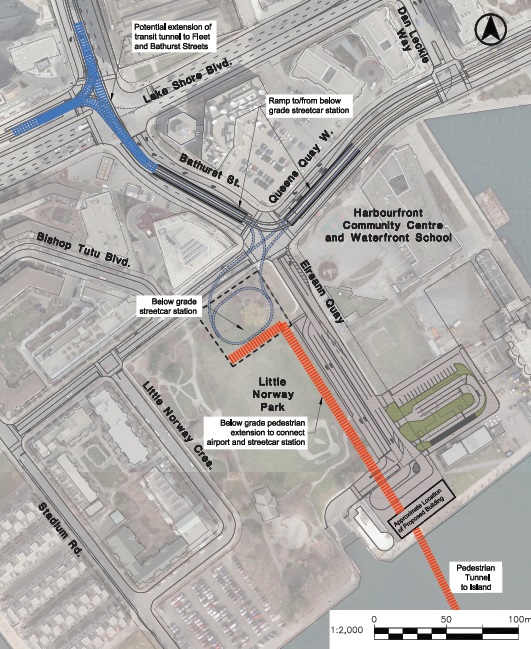 Potential Roadside improvement scheme from City consultants report, image courtesy fo City of Toronto
Potential Roadside improvement scheme from City consultants report, image courtesy fo City of Toronto
The new pedestrian tunnel to open this year plus the shuttle bus service is expected to curb some traffic, however City consultants say traffic vehicle movements could increase by over 280% from the present 620 to 1,745 movements per hour. City consultants have estimated traffic mitigation measures such as the one contemplated above could cost $300 million. These measures include extending roadways, underground facilities for airport arrivals and departure zones. The TPA has recently announced it is seeking $100 million dollars in federal and provincial funding to help implement some infrastructure and traffic mitigation measures.
Changes to traffic flows are all happening in the context of a neighbouring junior school and a growing surrounding residential community. A potential bridge built over the roadway is being considered as an option to help move children safely through the area. With the potential for increased traffic and pollution from jets being introduced, the city’s Board of Health unanimously voted to recommend against expansion, citing health concerns relating to the increased pollutants noise in the area which may contribute to future medical needs. Porter however claims that the jets will see an 80% per seat reduction in certain toxic emissions from the aircraft.
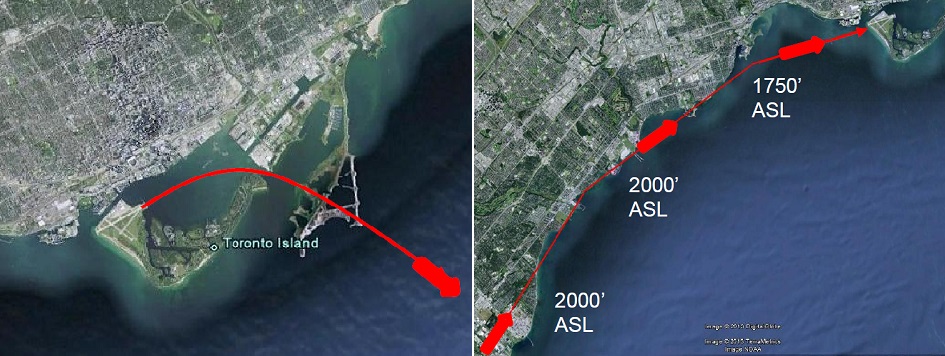 Left: Eastward Departure Flight Path. Right: Inbound Low Visability Flight Path, images courtesy of City of Toronto
Left: Eastward Departure Flight Path. Right: Inbound Low Visability Flight Path, images courtesy of City of Toronto
With the flight paths of the new planes still to be determined Porter has used the current flight paths of its Q400 turboprops as a stand in. The most controversial paths are shown above. The first sees jets flying across the Harbour, over the Portlands and over Tommy Thompson Park (formerly Leslie Spit) for take-off. The Toronto Region Conservation Authority has overseen the transformation of Tommy Thompson Park into a bird sanctuary and diverse habitat zone to including a recent multi-million dollar investment in pedestrian pavilions and tourism facilities. TRCA has expressed concerns about the impact that jet engines flying so close over the area could have on the important habitat. The second flight path as illustrated by Porter would see planes, as the now do, flying over communities from Missisauga to Etobicoke in tougher flying conditions. Though planes flying to Pearson regularly flying over communities in Etobicoke, the fear is increased noise and air pollution from more air traffic at low altitudes pose new risks. Porter and Bombardier however estimate the new jets to be 20% cleaner than current models and quieter as well, however with testing the plane still in testing phases, the true results cannot be known yet.
With the facts on the table , City Councillors will be hard pressed to make any decision quickly, but the issue is clearly one which affects the whole city, province, and even the country. While economic, health, social and environmental impacts all need to be considered, City staff have also pointed out that this proposal requires some deep thought about what the future of the Island Airport is and how it should fit into the Toronto of the future.
To check out some of the projects listed in the article, click the dataBase links below. Leave your comments below or join our Forum thread to join the discussion about the latest island airport plans. Additionally, be sure to communicate with your local politicians and join the public consultations process to make sure your voice is heard on this important topic.

 2.7K
2.7K 


















